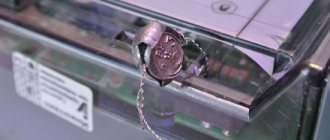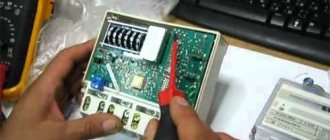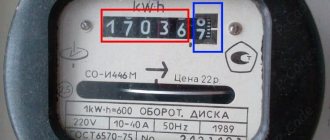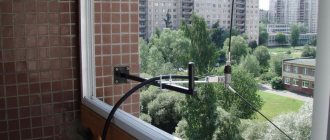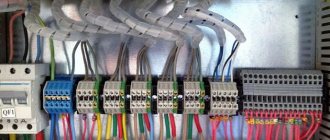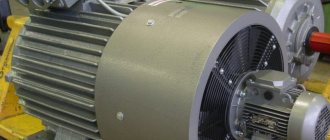Today we will talk about metering devices and which electric meter is best to install in an apartment. Theoretically, the meter is the responsibility of the company that sells you electricity, but in practice, this issue has to be resolved by the residents of the house or apartment. You are required to have a metering device and replace it as needed, for example, if it is old and does not meet modern requirements.
And here a big question arises - how to choose an electric meter for an apartment? If you can’t count them, like mosquitoes in summer. Offhand, any experienced electrician will name you a couple of dozen manufacturing companies from Russia and neighboring fraternal republics.
But even the coolest of us will not remember all the types, because there are more than four hundred names. And this is without imported electricity meters from Europe. In short, your eyes widen and your head spins if you need to buy an electric meter for an apartment, and even the price is a secondary issue.
So, we decided to write instructions on how to choose an electricity meter for an apartment or house.
Electricity meter for an apartment - design and characteristics
To understand how to choose, you need to know what we are choosing. As the rabbit in Winnie the Pooh said: “I come in different forms!”, the same picture applies to counters.
Induction and electronic
First of all, metering devices are divided by design.
Induction counter
was invented a long time ago and until recently only it was used. This is a familiar disk drive that is located on the site or right in the apartment. Inside such a device there are two magnetic coils, current and voltage. Their magnetic field rotates a disk connected to a counting mechanism, which takes into account the kilowatts used.
A distinctive feature of the induction meter is its reliability and long service life. According to the passport, at least 15 years, but in fact, such “electricity accountants” have been quietly working for 30-50 years. But the accuracy of the measurement is rather weak, as they say, only large fish are caught, and weak loads are missed.
Electronic counter
measures flow directly and appeared not so long ago. There are no moving measuring parts in it; consumption data is shown on the indicator board. An electronic recorder can store consumption figures and transmit them, for example, in automated smart home systems.
New devices can calculate energy consumption at several tariffs with high accuracy. Which, by the way, can be increased if you replace the microcircuit. Everything is taken into account, even the most minimal load from equipment in sleep mode.
Manufacturers promise that they will work for at least 10-15 years, but so far none have reached this age; they appeared only recently. As for reliability, we can say that the electronics can be glitchy, but in general, if done well, it works just as well.
Single-phase or three-phase meter for an apartment
Since electrical networks are single-phase, with a voltage rating of 220 V, and three-phase, with a voltage of 380 V, meters are produced in different types.
Most apartment residents have a single-phase electric meter. Our household electrical networks are designed for 220 Volts, as are home electrical appliances. Is a three-phase meter needed in an apartment with a single-phase network? More likely no than yes. Theoretically, if installed, it will keep track of electricity correctly. But the energy sales organization will simply refuse to register it.
A three-phase meter is usually needed in a private home. Much of the equipment there (boilers, water heaters, electric motors) runs on a three-phase network with a voltage of 380 V. There is also a 220-volt electricity meter in the house. He calculates the consumption of a single-phase network, that is, he is responsible for lighting and working irons, kettles, washing machines, TVs, etc.
Advice!
For an apartment, it is enough to buy a single-phase electronic electricity meter.
Evaluation of the metering device when choosing
Meter design type
There are only two types, differing in operating principle.
- Induction mechanical meters were once ubiquitous and familiar to everyone. The electric current passing through the meter induces an electromagnetic field, which causes the disk, which is probably so familiar to everyone, to rotate. Each revolution of the disk corresponds to a certain amount of current consumed. The rotation of the disk is mechanically transmitted to a counting device, from which the owners read the readings.
Induction meters are an old scheme, successfully used to this day.
Such devices are highly reliable - they last for decades without requiring repairs. Their cost is also low, which often becomes a decisive selection criterion. Disadvantages include large measurement errors. However, modern models of such metering devices fit well into the established accuracy standards.
Another disadvantage is that such meters cannot be used for multi-tariff consumption metering.
- In electronic meters, “information processing” is carried out by a special processor circuit. The passage of current generates a pulse signal, which is transmitted to the adding device. This allows you to significantly increase the accuracy of measurements and reduce the dimensions of the device itself. However, in size, many electronic meters are in no way inferior to induction ones.
Indications may vary. In many models, the usual mechanical type circuit is retained, with a set of “wheels” scales, by analogy with induction devices. In others, almost similar in other characteristics, a digital display is installed.
Meter models from the same manufacturer are similar in layout, size and operational characteristics, but differ in the reading indication system
When choosing an indication system, everyone decides for themselves (unless, of course, we are talking about a single-tariff device) - whichever is more convenient for them. For example, it is believed that for switchboards located on the street, it is better to purchase a model with an electromechanical indication. For devices that will be installed indoors, there is no difference, but it is more convenient to read readings from a digital display.
The disadvantages of electronic meters are their shorter service life, and this is against the backdrop of a higher price for the device itself. However, judging by the technical characteristics of popular models, this accusation is completely unfounded, and high-quality electronic meters serve no less than induction ones.
There is no need to wait for clear recommendations. But if the load in the apartment is low and the average monthly consumption is small, then it is quite possible to purchase a regular inexpensive induction device. If consumption is quite high and, naturally, if you want to switch to differentiated tariffs, you purchase an electronic one.
Number of phases
The devices can be designed for operation in a single-phase network of 220 V, or in a three-phase network - 380 V. As a rule, since we are talking specifically about apartments, three-phase options are not considered.
True, the apartment can be in a “house on the ground”. In this case, you will have to clarify which network is being used.
By the way, a three-phase meter is quite capable of operating in a 220 volt network. But reverse replacement is impossible.
Device current class
Here we must proceed from real needs and the diameter of the wiring that fits the meter. Many older models of metering devices were designed for low simultaneous loads, and often this circumstance becomes the reason for the need for replacement.
Single-phase meters can be produced with permissible current ranges from 5 to 80 amperes. For three-phase ones, this figure can reach up to 100.
As a rule, for an apartment with a fairly serious equipment of household appliances, the best option is to purchase a meter with current ranges from 5 to 50 amperes. This corresponds to a copper wire with a diameter of 6 mm. It is very difficult to imagine a situation where a simultaneous load in an apartment will require more than 10 kW (and 50 amperes at 220 volts is even about 11 kW of power).
In the vast majority of cases, a meter with a permissible current range from 5 to 50 amperes will be sufficient for an apartment. If the owners have any doubts, it is recommended to consult a good electrician.
No one is stopping you from purchasing a meter with higher permissible current ratings. The question is how justified this will be, since the cost of the device will become significantly higher.
Possibility of differentiated consumption metering
This is also one of the common reasons for purchasing a new meter. Apartment owners come to the conclusion that it would be more profitable for them to switch to a differentiated payment scheme for consumed energy. Therefore, the device itself must have a similar function.
Such meters can be two-tariff and multi-tariff. What is the difference?
This device is capable of keeping separate records of consumption only for two specified time periods
The two-tariff system, of course, is able to keep track of consumption only for two periods - night and day. A more complex option also provides, for example, for dividing the daily period into peak and semi-peak consumption zones. That is, in such devices it is possible to use three or even more (in some models - up to eight) separate accounting periods, both by hour of the day and by day of the week.
The capabilities of this model are wider - it is capable of calculating energy consumption at four tariffs
It is clear that electric meters with differentiated consumption metering will cost much more than conventional ones. How justified are both such a purchase and the transition to a similar type of payment for electricity? It would seem that the money spent on the purchase should soon pay off.
It is impossible to give universal recommendations on this matter. The owners of the apartment must make a decision themselves, but before that, carefully analyze the normal way of life that has developed in the family. Consider which appliances use them for maximum energy consumption, and how you can change their operating mode in order to achieve savings through lower tariffs. The fact is that in some regions tariff plans are designed in such a way that a decrease in the “night” cost of a kilowatt is accompanied by an increase in the “day” cost, which becomes higher than the usual “flat scale” tariff. It is possible that you may not only not benefit from such a transition, but also receive more serious bills to pay.
For example, look at the tariffs of one of the central regions of Russia for 2022:
| Electricity consumption time | Cost 1 kW/h |
| Regular tariff plan, without gradation by time of day | |
| Flat rate, regardless of time of day | RUB 3.53 |
| Two-tariff differentiated plan | |
| Day rate, from 7.00 to 23.00 | 4.06 rub. |
| Night rate, from 23.00 to 7.00 | 1.46 rub. |
| Three-tariff differentiated plan | |
| Peak consumption tariff, from 7.00 to 10.00 and from 17.00 to 21.00 | 4.59 rub. |
| Half-peak tariff, from 10.00 to 17.00 and from 21.00 to 23.00 | RUB 3.53 |
| Night rate, from 23.00 to 7.00 | 1.46 rub. |
Note: Electricity tariffs by region of the country may vary significantly. The table above is provided as an example only.
Look here. If you don’t actively use the most powerful electrical appliances in terms of energy consumption at night, then you won’t see any benefit at all, and you can even work at a loss.
For example, modern refrigerators have a very low consumption class. There is no point in running electric heaters at full power at night - the heat is not conducive to healthy sleep. That is, tangible savings can only be achieved if you postpone washing overnight (if possible), heat a large volume of water in the boiler, and operate the dishwasher.
In a word, you will have to carefully calculate everything so as not to pay a lot of money for a completely unnecessary metering device, the payback of which will be doubtful or will become a reality in a few years.
Electric meter accuracy class
This parameter is regulated by Chapter X of the Decree of the Government of the Russian Federation dated May 4, 2012, as last amended as of December 30, 2017. In particular, Article 138 states that consumer consumption meters must have an accuracy class of at least “2”. Collective metering meters in apartment buildings (in the section of competence zones of network management and intra-building networks) - class no less than “1”, but this is no longer relevant to a specific apartment.
If, at the time of entry into force of this legislative act, a meter with a lower accuracy class (for example, “2.5”) was installed, then it is allowed to operate until the end of the inspection interval, the complete expiration of its service life, or until it fails (whichever comes first) . And then – it is still necessary to replace it with a class of at least 2.
By the way, meters with a lower accuracy class have already been discontinued, and it is still impossible to purchase and install them.
The accuracy class is usually indicated on the front panel of the meter with a number circled
Is it worth pursuing a higher class for “1” or even “0.5”? To be honest, this doesn't make much sense if the average consumption level is low. The accuracy class shows the possible error of the device, expressed as a percentage. That is, for example, with a consumption of 120 kW, the error can be only 2.4 kW per month - completely insignificant. Moreover, the discrepancy may even be in favor of the consumer.
It’s a different matter if you have to operate with more significant indicators of consumption. For example, with 1000 kW, the error not in favor of the owners can amount to all 20 kW. This means there is something to think about.
One more nuance. The Government Resolution mentioned above is the main document. That is, no one has the right to force the apartment owner to purchase a meter of a higher accuracy class if this seems unprofitable to him for reasons of the cost of the device. He has every right to limit himself to “two”.
Layout of the meter and method of its installation in a panel or cabinet
Almost all electric meters of the old style had a common characteristic shape. This is a cylindrical block placed on a trapezoidal platform. Many models have retained this layout - convenient if the device has to be installed in an old-style electrical panel.
Such devices are fastened with three screws located at the vertices of a triangle, the dimensions of which are established by the standard. The shield has counter holes, and installation is carried out without much difficulty.
Standard dimensions of the “old layout” meter and mounting holes in the panel panel for installing the device
Another option is meters designed for installation in more modern electrical panels on a DIN rail. Such devices are usually rectangular box-shaped, and at the back they have a special groove with a latch. Installation of such models is even easier.
Example of dimensions of a meter designed for installation in a cabinet with a DIN rail
By the way, many device manufacturers practice producing meters that are completely identical in their operational parameters, but differ precisely in the layout and method of installation in the panel (cabinet).
Almost the same model in terms of its characteristics, but with a difference in layout and installation method
The required option, of course, is selected taking into account the specific location where the meter will be installed.
Meter release date and test interval
In accordance with current rules, any electricity metering device, after assembly in production, undergoes mandatory state verification of measurement accuracy. After this, the device is sealed with a seal indicating the date of inspection. When purchasing, be sure to pay attention to the integrity of this seal. Otherwise, employees of the energy supplier company have the right to refuse to install and register the meter.
When purchasing a meter, be sure to pay attention to the integrity of the factory seals
Next important point. There are time limits within which issued meters can be installed without additional inspection. For single-phase metering devices it is two years, for three-phase meters it is one year.
That is, when purchasing a meter, the date of its release must be checked. If the device is “overdue,” then it will either be refused installation, or you will have to send it for an unscheduled inspection, naturally, at your own expense.
It wouldn’t hurt to clarify the inspection interval established by the manufacturer. For some electronic type meters it is relatively small, that is, scheduled checks will be carried out more often. Induction models are more convenient in this regard, since their interval can reach 16 years.
Additional meter selection criteria
It is clear that such devices should be purchased exclusively in specialized stores. Often, an energy supplier company offers a certain range of devices - this can be clarified, for example, on its website. If there is no such information resource, then you should still ask the company’s employees which devices they recommend for installation and which they simply will not deal with.
- The completeness of the device must be checked. Any meter is accompanied by a passport (form) with a stamp indicating that it has passed control. The document must be completed and certified in the prescribed manner. The form must specify both the maximum service life of the device and the value of the inspection interval.
The technical documentation accompanying the metering device must be completed and certified accordingly
- Any energy meter, no matter whether it is domestic or foreign, must be listed in the State Register, that is, be certified and approved for use on the territory of the Russian Federation.
- When choosing a device, you can pay attention to some additional points:
— The meter can be designed for any operating temperatures or only for installation in a heated room.
— Some devices show quite sensitive noise levels. If this is important, that is, the meter will be installed in a residential area, then this point should be clarified when choosing.
— It is possible that the energy supplier company has implemented or is planning to introduce an automatic consumption metering system in the near future. This means that you will need to purchase a meter with built-in feedback channels (GSM, IP or PLS). This point should also be clarified in advance so that you do not have to purchase a more advanced device in the near future.
— Modern models of meters can be equipped with additional functions. This includes the ability to take instant current readings of voltage, current, active and reactive power. The built-in memory cells of the device can store information about energy consumption by month - this option is sometimes useful for resolving conflicts. The memory can also keep a so-called “event log” in which, for example, the date and time of peak load, power surges in the network or a complete shutdown, the time the device was opened or attempted unauthorized interference with the operation of the device, etc. will be recorded.
It should be correctly understood that any additional option is an “add-on” to the cost of the metering device. But as practice shows, most of these “bells and whistles” remain unclaimed by the consumer, and, therefore, do not justify these extra costs.
- And one moment. Purchasing an electric meter for an apartment is just that pleasant case when there is no need to look for an imported model. Devices produced by Russian companies are highly reliable and durable, and at the same time have a very affordable price.
What kind of meter is needed for the apartment - multi-tariff or single-tariff
Previously, all metering devices were induction and single-tariff. With the advent of electronic ones, it became possible to count consumed electricity at several tariffs - two, three or more.
A multi-tariff registrar calculates consumption by time, for example, a two-tariff one for the day zone - from 7 am to 11 pm and for the night zone - from 11 pm to 7 am.
Daytime energy is more expensive, nighttime energy is cheaper, therefore, you can schedule the operation of energy-intensive equipment at night. Start washing there or turn on the heater. Profitable? Yes, but here's the story. The difference in day and night tariffs is large in some places, and practically none in others, but a multi-tariff meter is always more expensive than a single-tariff meter.
Therefore, before choosing to pay at several rates, estimate your monthly expenses and break them down into day/night periods. And then calculate according to one tariff. If the savings are half of the single-tariff payment or at least a third, then it makes sense to install a multi-tariff device. It will pay for itself and save your money.
If the difference is 100-200 rubles, then there is no point in bothering with multi-tariff payments. The equipment will not pay for itself soon and the savings are purely symbolic. In this case, it is better to think about smart energy management.
A multi-tariff electricity meter for a home must also be selected based on consumption and taking into account the equipment with powerful electrical equipment. If a water heater or partial electric heating is working, then it is more profitable to use them as much as possible at a cheap nightly rate.
TOP 4 electronic meters
Such devices are capable of operating at differential tariffs, they are compact and characterized by good accuracy. But they are much more expensive than mechanical meters, and they do not last as long.
4No4. Legrand Counter 3F Ch/Trans 5A
This device is equipped with a fairly large eight-digit display, as well as a pulse output. Can remotely transmit information about electricity consumption (the specific transmission distance is affected by the caliber of the transformer). The display, in addition to consumption data, also indicates the current voltage (within 110-230 V). The current value is no more than 60 A.
pros
- high accuracy;
- remote reading of indicators;
- resistance to voltage surges;
- wide display.
Minuses
- Dust and moisture protection is not provided.
Prices for Legrand Counter 3F Ch/Trans 5A
Legrand Counter 3F Ch/Trans 5A
3No3. SchneiderElectric A9MEM3250R
The device monitors various indicators, including power, active energy, etc. Consumption can be controlled from a specific moment for more accurate tracking of electricity consumption. There are LED indicators that notify you of a number of processes. Supports systems with nine customizable tariffs.
pros
- ease of installation;
- color indicators;
- external control;
- multiple tariffs.
Minuses
- There is no reverse stop.
Prices for SchneiderElectric A9MEM3250R
SchneiderElectric A9MEM3250R
2No2. Skat 105E/1-5 SHOI4 P1 PROxima
The device has a long warranty period and an excellent protection class of IP54. This means that the main components are not afraid of either dust or moisture. The model weighs 362 g, the maximum permissible current is traditionally 60 A. It is easy to install, since the case is mounted on a DIN rail and a one-way connection is provided.
pros
- compactness;
- seven-year warranty;
- electronic indicators;
- dust and moisture protection.
Minuses
- does not come with fastenings.
Prices for electric meter Skat 105E/1-5 SHOI4 P1 PROxima
electric meter Skat 105E/1-5 SHOI4 P1 PROxima
1No1. ABB E31 412-200
The original compact housing of the device contains 5 modules and has a large terminal cover. The maximum permissible load is 80 A, more than one tariff can be installed. The design of the meter is non-separable, there is an electronic seal.
On a note! The model can store data for several tariffs throughout the year. An excellent option for multi-tariff accounting systems.
pros
- ease of installation;
- ability to save indicators;
- dust and moisture protection;
- small sizes;
- the main parameters of the network are measured.
Minuses
- The initial setup is not easy.
Prices for ABB E31 412-200
ABB E31 412-200
How to choose an electricity meter for your home according to accuracy class
Electric meters differ not only in design and number of tariffs, but also in accuracy class. Any device has a measurement error. The accuracy class is the maximum error.
According to modern requirements, an electric meter in an apartment or house must have an accuracy class of 2.0 or lower.
That is why they are forced to change old induction devices, which have an accuracy class of 2.5%. What's the practical point? The higher the error rate, the more the device will miss a weak load and will not count it. For example, many home electrical appliances are in standby or sleep mode part of the time. The energy consumption is small, but it is still there. A meter with a lower error (1-2%) will calculate such consumption, but a meter with a high error (2.5%) will simply not notice it. This is beneficial for the consumer, but not at all beneficial for energy sales. The undercount turns out to be quite significant.
On the other hand, if you “plug in” a device with an accuracy class of 0.2% instead of two, you will create a holiday for energy sales and a problem for yourself. Your accurate meter will “give” inflated consumption readings. In essence, you will be paying for yourself and your neighbor.
Our advice!
Take an electric meter for your house or apartment with an accuracy class of 2.0. The requirements indicate an “upper limit” of error - use this. Send everyone who is forced to install the device with greater accuracy to read the rules.
